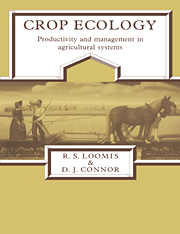Book contents
- Frontmatter
- Contents
- Preface
- Part I Farming systems and their biological components
- Part II Physical and chemical environments
- Part III Production processes
- Part IV Resource management
- 12 Soil management and sustainability
- 13 Strategies and tactics for rainfed agriculture
- 14 Water management in irrigated agriculture
- 15 Energy and labor
- 16 Analysis of wheat–sheep farming in southern Australia
- 17 Mixed farming in the North American Corn Belt
- 18 Towards an uncertain future
- References
- Species list
- Conversions and constants useful in crop ecology
- Index
16 - Analysis of wheat–sheep farming in southern Australia
from Part IV - Resource management
Published online by Cambridge University Press: 05 June 2012
- Frontmatter
- Contents
- Preface
- Part I Farming systems and their biological components
- Part II Physical and chemical environments
- Part III Production processes
- Part IV Resource management
- 12 Soil management and sustainability
- 13 Strategies and tactics for rainfed agriculture
- 14 Water management in irrigated agriculture
- 15 Energy and labor
- 16 Analysis of wheat–sheep farming in southern Australia
- 17 Mixed farming in the North American Corn Belt
- 18 Towards an uncertain future
- References
- Species list
- Conversions and constants useful in crop ecology
- Index
Summary
INTRODUCTION
In southern Australia most wheat is grown on farms that also produce sheep for wool and for meat (prime lambs). Successful farming began in this region in the 1800s with wheat grown in an alternating sequence with bare fallow while sheep grazed on separate grass pastures. The legume content of those pastures was low because the soils were deficient in phosphorus and often in molybdenum also. Under that early system, yields of wheat, originally near 1 t ha-1, had fallen to around 0.5 t ha-1 by 1900 owing to the loss of soil N and the build-up of soil-borne diseases. Carrying capacity of those pastures was around 2 sheep ha-1, relatively low for the rainfall.
The advantages of introducing legumes into pasture and growing them in sequences (rotations) with cereal crops to increase the productivity of both crop and pasture was recognized by the 1930s. Suitable pasture legumes had been available since the turn of the century but it was not until the 1950s, when wool prices increased, that the widespread use of phosphorus fertilizer became profitable.
The present legume–wheat system continues to evolve in response to changing ecological and economic conditions. A traditional cropping sequence was two to four crops of wheat following several years of leguminous pasture. In recent years, developing markets and acceptable prices for grain legumes (pea, lupin, faba bean) and rapeseed have made it possible to include them in more complex pasture–crop rotations.
- Type
- Chapter
- Information
- Crop EcologyProductivity and Management in Agricultural Systems, pp. 428 - 449Publisher: Cambridge University PressPrint publication year: 1992



